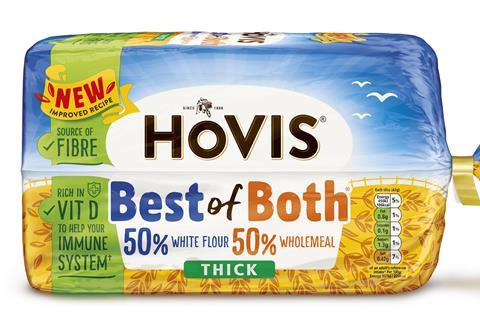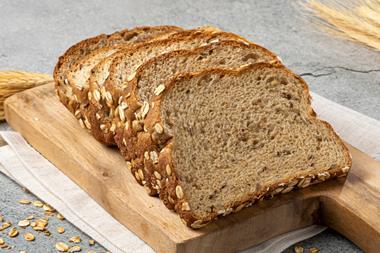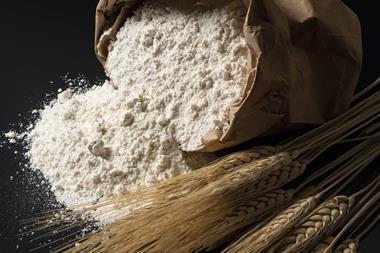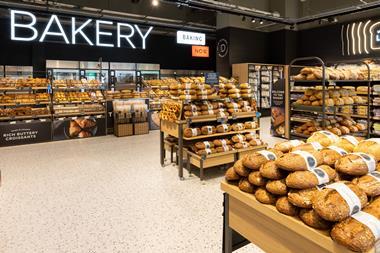
Half and half loaves won’t have to change their packaging to remove the use of the word ‘wholemeal’ from the front of pack, an industry statement has revealed.
Manufacturers of the UK’s major bread brands and some retailers have been challenged regarding the use of the term ‘wholemeal’ in relation to bread products containing non-wholemeal flours, raising the question of whether they would have to rename 50/50 loaves (bread made from 50% white and 50% wholemeal flour).
However, an industry position statement published by the Federation of Bakers, following legal counsel on the matter, states that “manufacturers are legally compliant with their interpretation of Regulation 6-(1)” meaning they won’t have to change product names or packaging as a result.
The document, seen by British Baker, outlines the use of the term ‘wholemeal flour’ for half and half bread in relation to Regulation 6-(1) of The Bread and Flour Regulations 1998. It was produced by the Federation of Bakers, which represents large scale bakers producing branded and private label bread and baked goods, with collaboration from the Food and Drink Federation and UK Flour Millers.
“The use of the term ‘wholemeal’ in relation to bread products containing a mix of wholemeal and non-wholemeal flours on both the packaging and in marketing communications is compliant with The Regulation. This is principally on the basis that ‘wholemeal’ is not used in the name of the product (i.e., wholemeal bread),” the industry position states.
The trade body’s point hinges on the inclusion of the clause ‘as part of the name of the bread’ in Regulation 6-(1), which it said clearly qualifies the meaning of the rest of the provision. “Had the intention of Parliament been to restrict the use of the term ‘wholemeal,’ this would have been straightforward. In fact, the 1963 Bread and Flour Regulations did just that.”
It added that the interpretation by campaign groups “misrepresents the literal meaning and intention” of the regulations, but it would welcome “clarifying authoritative guidance on this issue” from Defra.
Consumer protection
The Real Bread Campaign had complained to the trading standards departments responsible for the bread brands/retailers over their use of the term wholemeal in 50/50 loaves. Its argument gained traction with a couple of instances of product name changes or removal as a result.
In response, the recent industry position statement said it was vital to respect the underlying consumer protection aims of the bread and flour regulations. It added that, having been around for more than 20 years, these types of bread are understood by consumers.
“In most cases the name of the product recognised by the consumer is the marketing name i.e., Best of Both; 50/50; Half & Half; Both in one, Bloomin’ Both. In contrast, the use of the word ‘wholemeal’ is wholly descriptive of the ingredient ‘wholemeal flour’ within the product and as such lacks any distinctive characteristic in the mind of the average consumer,” it said.
Accordingly, the industry is confident that the product name along with its description is “sufficiently clear and consumers have enough information to make an informed decision when buying a ‘half & half’ product”. The information is consistent with the overriding consumer protection duties set out in the Consumer Protection from Unfair Trading Regulations 2008, it added.
“The nature of half & half breads appears well understood by consumers. Importantly, the product is also unlikely to be looked at in isolation. Shoppers clearly see white, wholemeal, and half & half breads offered for sale together, with the ‘average’ consumer readily distinguishing between the different breads,” the position statement said.
It went on to outline that government advice is that wholemeal is beneficial to consumers owing to its fibre content and that relegating the term ‘wholemeal flour’ to the ingredients list “would be a retrograde step”.
The statement comes just over a week after Defra confirmed changes to the regulations, including the addition of folic acid to flour. Defra also said it would be introducing a ‘legal description that means wholemeal flour must consist of the whole product from the milling and grinding of cleaned cereal’.
Real Bread Campaign responds
Chris Young, coordinator of the Real Bread Campaign (RBC), responded to the Federation’s industry statement, saying: ”The wording of the law is clear: in order to be able to use the word wholemeal in naming and advertising a product, all of the flour must be wholemeal.”
Young claimed this was re-enforced last year by Defra confirming to trading standards officers that the Regulations prohibit the use of the term wholemeal in the naming of advertising of these products. ”Defra also stated that the word wholemeal should appear on the ingredients list but nowhere else,” he noted, adding ”we are amazed that the Federation of Bakers has gone to the extent of hiring lawyers to come up with an opinion in order to dispute this”.
According to Young, Defra had followed its response to the public consultation on amending the Bread and Flour Regulations last week by advising the RBC that it was anticipating “laying the amending legislation” in the summer.
“Defra has said that use of the word wholemeal will be included in its new guidance to the revised Regulations, which we assume will be in line with what they previously stated,” commented Young. ”Resolution to this unnecessary state of limbo cannot come too soon for consumer protection officers, manufacturers and the rest of us as food buyers.”
The RBC’s investigation, which began in June 2022, included loaves such as Iceland’s 50% White and Wholemeal; Lidl’s Rowan Hill Two In One White & Wholemeal; and Warburtons’s Half White Half Wholemeal. Iceland discontined its product in January 2023, while Warburton’s recently renamed its loaf ’Half & Half’.
In July 2023, the RBC wrote to bosses at Aldi, Asda, The Co-op, Sainsbury’s, Marks & Spencer, and Waitrose asking why wheat flour with added calcium carbonate, niacin, iron and thiamine appears on the ingredients list of some of their wholemeal loaves. “Most of these cases are still being investigated by trading standards officers at the companies’ Primary Authorities, a number of which say they are waiting for the guidance promised by Defra before they do anything further,” revealed Young.
































No comments yet